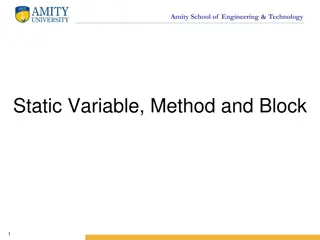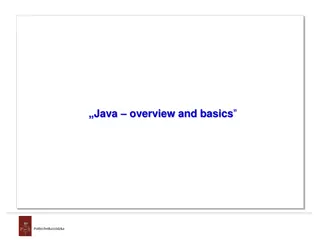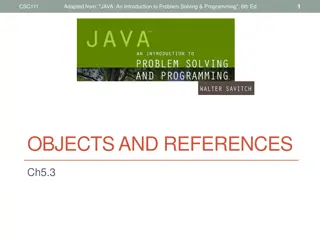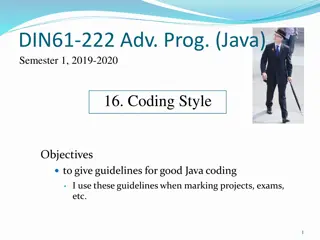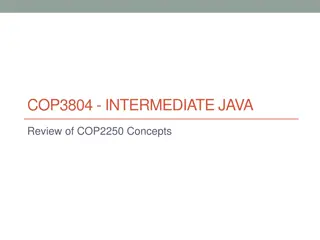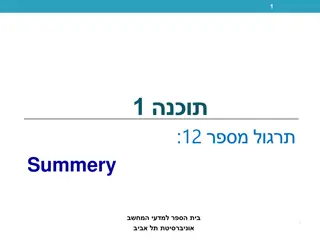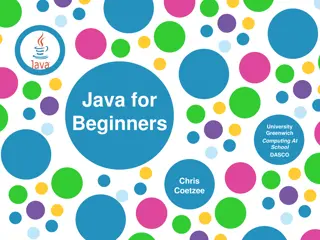
Class Hierarchy and Java Variables
In this content, you will learn about the class hierarchy in Java programming, static components, and the fundamental concepts of Java variables. It covers topics such as defining new types with classes, operations on objects, and the structure of a class like House with constructor and methods. Explore the relationship between classes, objects, and inheritance in Java programming.
Download Presentation

Please find below an Image/Link to download the presentation.
The content on the website is provided AS IS for your information and personal use only. It may not be sold, licensed, or shared on other websites without obtaining consent from the author. If you encounter any issues during the download, it is possible that the publisher has removed the file from their server.
You are allowed to download the files provided on this website for personal or commercial use, subject to the condition that they are used lawfully. All files are the property of their respective owners.
The content on the website is provided AS IS for your information and personal use only. It may not be sold, licensed, or shared on other websites without obtaining consent from the author.
E N D
Presentation Transcript
1 Lecture 4: The class hierarchy; static components http://cs.cornell.edu/courses/cs2110 CS/ENGRD 2110 FALL 2018
Announcements 2 A1 Due Friday A2 Out Today
Where am I? Big ideas so far. 3 Java variables have types (L1) A type is a set of values and operations on them (int: +, -, *, /, %, etc.) Classes define new types (L2) and define the contents of each object of the class. Methods are the operations on objects of that class. Fields allow objects to contain data (L3)
Class House 4 public class House { privateint nBed; // number of bedrooms, >= 0. privateint nBath; // number of bathrooms, in 1..5 /** Constructor: bed is number of bedrooms, * bath is number of bathrooms * Prec: bed >= 0, 0 < bath <= 5 */ public House(int bed, int bath) { nBed= bed; nBath= bath; } /** Return no. of bedrooms */ publicint getNumBed() { return nBed; } House@af8 nBed nBath House( ) getNumBed() getNumBath() setNumBed( ) setNumBath( ) toString() equals(Object) hashCode() House 3 1 Contains other methods!
Class Object: the superest class of all 6 public class House { privateint nBed; // number of bedrooms, >= 0. privateint nBath; // number of bathrooms, in 1..5 extends Object { Java: Every class that does not extend another class extends class Object. /** Constructor: bed is number of bedrooms, * bath is number of bathrooms * Prec: bed >= 0, 0 < bath <= 5 */ public House(int bed, int bath) { nBed= bed; nBath= bath; } /** Return no. of bedrooms */ publicint getNumBed() { return nBed; } } House@af8 nBed nBath House( ) getNumBed() getNumBath() setNumBed( ) Object House 3 toString() equals(Object) hashCode() 1
Class Object: the superest class of all 7 public class House { privateint nBed; // number of bedrooms, >= 0. privateint nBath; // number of bathrooms, in 1..5 extends Object { Java: Every class that does not extend another class extends class Object. /** Constructor: bed is number of bedrooms, * bath is number of bathrooms * Prec: bed >= 0, 0 < bath <= 5 */ public House(int bed, int bath) { nBed= bed; nBath= bath; } /** Return no. of bedrooms */ publicint getNumBed() { return nBed; } } House@af8 nBed nBath House( ) getNumBed() getNumBath() setNumBed( ) Object House 3 toString() equals(Object) hashCode() 1 We often omit the Object partition to reduce clutter; we know that it is always there.
Class Object: the superest class of all 8 public class House { privateint nBed; // number of bedrooms, >= 0. privateint nBath; // number of bathrooms, in 1..5 extends Object { Java: Every class that does not extend another class extends class Object. /** Constructor: bed is number of bedrooms, * bath is number of bathrooms * Prec: bed >= 0, 0 < bath <= 5 */ public House(int bed, int bath) { nBed= bed; nBath= bath; } /** Return no. of bedrooms */ publicint getNumBed() { return nBed; } } House@af8 Object toString() equals(Object) hashCode() House nBed nBath House( ) getNumBed() getNumBath() setNumBed( ) 3 1 We often omit the Object partition to reduce clutter; we know that it is always there.
Classes can extend other classes We saw this in L2! 9 /** An instance is a subclass of JFrame */ public class C extends javax.swing.JFrame { } C@6667f34e C: subclass of JFrame JFrame: superclass of C C inherits all methods that are in a JFrame equals() toString() Object JFrame hide() show() setTitle(String) getTitle() getWidth() getHeight() object has 3 partitions: for Object components, for JFrame components, for C components getX() getY() setLocation(int, int) C
Classes can extend other classes 10 You also saw this in the tutorial for this week's recitation NFE@2 Object There are subclasses of Exception for different types of exceptions Throwable Exception NumberFormatException
Accessing superclass things 11 Subclasses are different classes Public fields and methods can be accessed Private fields and methods cannot be accessed Protected fields can be access by subclasses
Keywords: this 12 publicclass House { privateint nBed; // number of bedrooms, >= 0. privateint nBath; // number of bathrooms, in 1..5 this.nBed= nBed; this.nBath= nBath /** Constructor: */ public House(int nBed, int nBath) { nBed= nBed; nBath= nBath; } } this evaluates to the name of the object in which it occurs // has no effect! Inside-out rule shows that field nBed is inaccessible! this avoids overshadowed field names Makes it possible for an object to access its own name (or pointer) Example: Referencing a shadowed class field
A Subclass Example 13 public class House { privateint nBed; // num bedrooms, >= 0 privateint nBath; // num bathrooms, in 1..5 public class Apt extends House { private int floor; private Apt downstairsApt; /** Constructor: bed is number of bedrooms * bath is number of bathrooms * Prec: bed >= 0, 0 < bath <= 5 */ public House(int bed, int bath) { nBed= bed; nBath= bath; public Apt(int floor, Apt downstairs) { this. floor= floor; downstairsApt= downstairs; } }
Overriding methods 14 Apt@af8 Object defines a method toString() that returns the name of the object Apt@af8 Object toString() equals(Object) hashCode() House nBed nBath House( ) getNumBed() getNumBath() setNumBed( ) 3 1 Java Convention: Define toString() in any class to return a representation of an object, giving info about the values in its fields. Apt floor downstairsApt 2 New definitions of toString() override the definition in Object.toString() Apartment@f34 Apt( ) isBelow( ) toString()
Overriding methods 15 Apt@af8 public class Apt{ Object toString() equals(Object) hashCode() /** Return a representation of an Apartment*/ @Override public String toString() { return "" + (getNumBed() + getNumBath()) + " room apartment on " + floor + "th floor"; House nBed nBath House( ) getNumBed() getNumBath() setNumBed( ) 3 1 Apt floor upstairsApt Apartment@f34 2 } Apt( ) isBelow( ) toString() toString() } a.toString() calls this method
When should you make a subclass? 16 The inheritance hierarchy should reflect modeling semantics, not implementation shortcuts A should extend B if and only if A is a B An elephant is an animal, so Elephant extends Animal A car is a vehicle, so Car extends Vehicle An instance of any class is an object, so AnyClass extends java.lang.Object Don t use extends just to get access to protected fields!
When should you make a subclass? 17 Which of the following seem like reasonable designs? Triangle extends Shape { } PHDTester extends PHD { } BankAccount extends CheckingAccount { } A. B. C.
When should you make a subclass? 18 Which of the following seem like reasonable designs? Triangle extends Shape { } Yes! A triangle is a kind of shape. PHDTester extends PHD { } No! A PHDTester tests a PHD, but itself is not a PHD. BankAccount extends CheckingAccount { } No! A checking account is a kind of bank account; we likely would prefer: CheckingAccount extends BankAccount { ... } A. B. C.
Static Methods 19 Most methods are instance methods: every instance of the class has a copy of the method There is only one copy of a static method. There is not a copy in each object. Make a method static if the body does not refer to any field or method in the object.
An Example 20 /** returns true if this object is below Apt a . Pre: a is not null. */ public Boolean isBelow(Apt a){ return this == a.downstairsApt; } /** returns true if Apt b is below Apt a Pre: b and c are not null. */ publicstaticboolean isBelow(Apt b, Apt a){ return b == a.downstairsApt;
Referencing a static method static: there is only one copy of the method. It is not in each object 21 Apt@af nBed 2 nBath 1 Apt@b4 nBed 2 nBath 1 House House Apt Apt floor 4 dstrs Apt@af isBelow(Apt) floor 4 dstrs Apt@af isBelow(Apt) isBelow(Apt, Apt) Container for Apartment contains: objects { a= new Apt(...); b= new Apt(...); if (a.isBelow(b)) ... if (Apt.isBelow(a, b)) ... } , static components
Good example of static methods 22 java.lang.Math http://docs.oracle.com/javase/8/docs/api/java/lang/Math.html Or find it by googling Java 8 Math
Static Fields 23 There is only one copy of a static method. There is not a copy in each object. There is only one copy of a static field. There is not a copy in each object. What are static fields good for?
Use of static variables: Maintain info about created objects 24 public class Apt extends House { public staticint numApt; // number of Apartments created /** Constructor: */ publicApt( ) { numApt= numApt + 1; } Apt@af nBed 2 nBath 1 Apt@b4 nBed 2 nBath 1 H H Apt Apt floor 4 dstrs Apt@af floor 4 dstrs Apt@af } To have numApt contain the number of objects of class Apartment that have been created, simply increment it in constructors. numApt 0 2 numAps stored in the Container for Apartment To access: Apartment.numApt
Class java.awt.Color uses static variables 25 An instance of class Color describes a color in the RGB (Red-Green- Blue) color space. The class contains about 20 static variables, each of which is (i.e. contains a pointer to) a non-changeable Color object for a given color: public static final Color black= ; public static final Color blue= ; public static final Color cyan= new Color(0, 255, 255); public static final Color darkGray= ; public static final Color gray= ; public static final Color green= ;
Uses of static variables: Implement the singleton pattern 26 Only one WhiteHouse can ever exist. public class WhiteHouse extends House{ private static final WhiteHouse instance= new WhiteHouse(); private WhiteHouse() { } // ... constructor public static WhiteHouse getInstance() { return instance; } WhiteHouse@x3k3 WH // ... methods } instance Container for WhiteHouse WhiteHouse@x3k3





